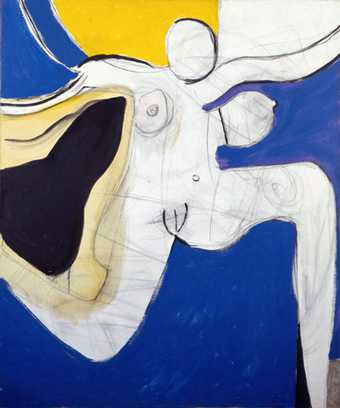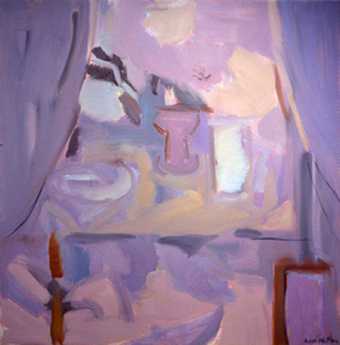When I arrived at the Royal College of Art in 1953 it was a traumatic experience. I had come from a Plymouth Brethren family. We had Bible reading after breakfast, so the change was such a shock that my body couldn’t take it. In the summer of 1954 I got tuberculosis and was sent to a sanatorium. I spent the whole year reading and returned to the RCA the following summer. I didn’t really learn much from the tutors there. Rodrigo Moynihan was the professor and you never saw him, but he gave me a first so he must have noticed what I was doing. I actually learned much more from Roger [Hilton]. He translated all the French laws of painting that he had learned. My painting was different from his. He used to call mine old-fashioned because they were still lifes. I really admired his work, but I didn’t know how he did it.
When Roger and I got together I did a lot less painting. The reason for this was that Roger had said: “If you are going to be with me, then I’m going to be the painter.” By that time I was in love with him, so I thought that was my destiny. He was someone who spoke his mind and he did not lie. For me that was a magnet. We moved down to Cornwall and had two children. There were quiet times when he was in his studio, or sleeping, or out with the poet Sidney Graham, when I would do some painting. I would bring my pictures into his studio at the back of the house. He would look at them for a long time and then tell me which areas needed working on.
This exhibition at Tate St Ives includes work from the past 50 years. The earliest is a life painting done at the Royal College just before I got ill. Many pictures reflect how the landscape and the weather have influenced both my palette and the subject. For example, in Grey Kitchen 2004 I deliberately set out to convey the sense of the soft, all-over greys of Cornwall sky and sea. Winter Botallack 2004 is a reaction to the strong winds that we get. I often walk my dog on Botallack Moor, and in this painting I was overcome by the wildness of the place, of the magenta coloured heather on the moor and the feel of the sea.
Alongside my own paintings I have chosen a selection of works from the Tate collection that I like or have some particular connection with me. For example, The Sleeping Fool 1943 by Cecil Collins. After Roger died I rented a flat in London and went to drawing classes at Central School of Art that were taught by Collins. He had an incredibly unorthodox way of conducting a class. He would bark out orders from the corner of the room in rapid succession to keep you doing completely new things. He would say: “Take up your quill pen… now take up your reed pen… now take up the pose of the model…” and then the whole class would be writhing about on the floor. He didn’t like the idea of a good academic drawing. He wanted your drawings to have a real energy to them. His approach was very unpopular with the college.
Not surprisingly, I’ve chosen works by Bonnard and Matisse. The teaching at the RCA was all about tonal painting, so I discovered colour later on, through looking at French paintings. Roger had trained in France and his work was grounded in the European tradition. His criticism of my paintings had a big influence on the development of my work and my attitude to colour. There is also October Painting, Yellow and Blue 1963 by Ivon Hitchens. Roger thought Ivon was a great painter (though he said that he couldn’t paint women). I think Hitchens broke new ground with landscape painting. He knew what he was doing. He would make preparatory drawings and then make a painting based on them – which is not something that you would think looking at the finished work. He made his paintings appear effortless. I love the freedom that they have, and they make sense as paintings.


